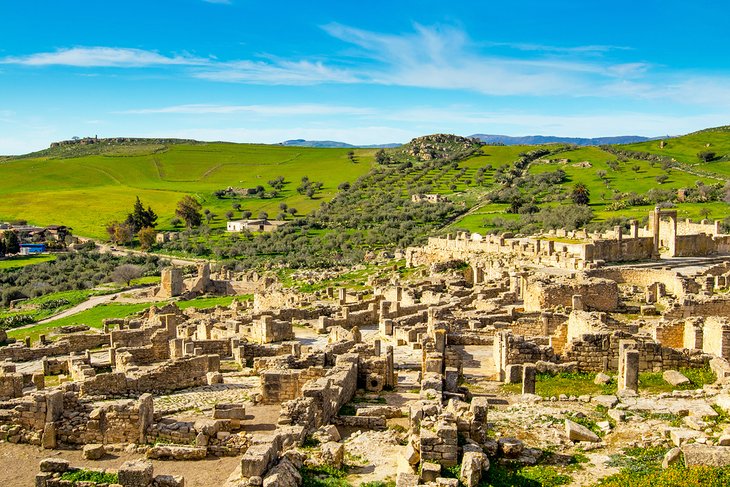Tunisia is a land of striking contrasts – sandy beaches, history-rich cities, refined monuments and rugged mountain landscapes are woven together like threads from an intricate tapestry. Phoenicians, Carthaginians and Romans all left their mark here as their cultures flourish alongside its diverse natural scenery.
Don’t get left behind the package-tour crowd when you step aboard a louage (long-distance shared taxi) to discover Dougga, an ancient Roman city located nearby or simply indulge in delicious garlicky-grilled prawns and steaming couscous for lunch or dinner!
Inspirational Ideas for Planning Your Trip
Tunisia encapsulates everything wonderful about North Africa from sparkling beaches to jaw-dropping ancient ruins, from medina alleyways in Tunis to Kairouan’s UNESCO-listed sultanate city and Chott El Jerid’s vast sand dunes. Attractively designed street markets offer freshly baked brik while sampling some local wine in Sidi Bou Said can all add up to an unforgettable journey!
Carthage and Dougga are famed for their well-preserved Roman ruins, yet Tunisia offers plenty of other interesting sites as well. One such attraction is the Bardo Museum located within an opulent Tunis palace which features one of the world’s premier collections of mosaic art – something Carthage and Dougga do not boast.
Traveling across Tunisia by bus or train is convenient, but to maximize the experience it is advisable to rent a car and explore each destination at your own pace. There are also tours that include transportation costs in their price tags to guarantee you see all the sights as soon as possible.
Best Time to Visit Tunisia
If you want to experience Tunisia’s famed beaches, summer is the time for it. Temperatures remain hot and sunny with minimal rain in this season. Additionally, this is an excellent opportunity to visit historical landmarks like Carthage, Bardo Museum, Tunisian Medina etc.
Spring shoulder season in Tunisia can also be an attractive option, particularly April and May, with its warm yet not overbearing temperatures and reduced crowds on its charming beaches.
Fall and winter travel to Tunisia is also possible, although you should expect slightly more rainfall. Exploring during this period offers reduced rates as well as opportunities to see lesser-known gems like Sidi Bou Said on high cliffs overlooking the Mediterranean Sea; also ancient ruins and markets without the massive crowds commonly found during peak summer season travel periods.
Visitors Guide to Tunisia
Tunisia stands out as one of North Africa’s more politically moderate nations, combining traditional Islamic culture with remnants from its ancient past. From Carthage’s UNESCO listing to Sidi Bou Said’s whitewashed streets – Tunisia will captivate even the most adventurous traveler!
Tunis is an intriguing blend of old and new, featuring historic buildings and mosques alongside modern boutiques, cafes and restaurants with European influences. A walk through Medina district’s maze of narrow streets will bring the Tunisian lifestyle closer to your grasp.
Tunisia is generally safe to travel in, though the government remains concerned over Libya’s ongoing civil conflict, which could impede travel within Tunisia. Be mindful of what’s happening and check local media for updates that could influence your trip; be ready with at least six months validity on your passport and comprehensive health coverage before planning a visit.
Best Towns in Tunisia
Tunisia is an incredible North African gem that perfectly blends Islamic tradition with more modern influences, evidenced by ancient medinas in cities like Tunis, which boast incredible architecture and shopping opportunities.
Sidi Bou Said is one of Tunisia’s most stunning Mediterranean towns. Just an easy train ride away from Tunis, Sidi Bou Said feels like the sister island to Santorini or Mykonos with its white stones and vibrant blue accents, as well as stunning beaches that rival any in the Mediterranean region.
Hammamet is another haven of artisans, featuring shops specializing in handmade goods and souvenirs as well as being home to the International Cultural Center of Hammamet which hosts spectacular live performances and music festivals.
Kairouan, located further inland, is a key pilgrimage destination for Muslims and a UNESCO World Heritage Site, boasting several mosques that make the city an essential spiritual space.
Historic Highlights of Tunisia
Tunisia is an incredible land filled with history that’s easy to get lost in, stunning landscapes and delicious cuisine that are sure to tantalize any traveller’s senses.
Tunis is one of the country’s premier tourist spots and makes an excellent base for sightseeing trips across Tunisia and North Africa. Explore its Medina and historic landmarks such as El Djem Amphitheater – Africa’s third-largest amphitheater! You may also wish to visit Carthage (founded by Dido according to Virgil’s Aeneid), Carthage itself (founded by Dido according to legend) and Kerkouane on Cap Bon a Phonecian town abandoned after Carthaginian defeat by Rome.
Traveling within Portugal is fairly straightforward with a range of public transportation options. A popular mode is a shared taxi called ‘Louage’ which you can hail down on the street or find at designated stations; other transportation includes buses and private transfers; for the ultimate experience join an organized tour, which will include all transportation needs; or rent a car and explore at your own pace!
Essential Stats & Facts
Tunisia offers something to satisfy travelers of all types; from its picturesque seaside town of Sidi Bou Said that recalls Santorini to intense desert landscapes that were featured in Luke Skywalker and The English Patient movies, Tunisia can offer surprises for every kind of traveler. Trailblazers seeking authentic North Africa experiences will find Tunisia still relatively unspoiled and ideal as a travel destination.
At any visit to the capital city, a visit to the Medina is an absolute must, where its maze-like streets lead past ancient palaces and restored dars (medina mansions). Don’t miss seeing Umayyad-era Olive Tree Mosque up on its rooftop and strolling back alleys where artisans are at work!
Kairouan, Islam’s fourth holiest city and a UNESCO World Heritage Site, should also be on any traveler’s itinerary. The Great Mosque here is one of the most impressive structures in the region with its marble courtyard and graceful arches; non-Muslim visitors are unfortunately not permitted entry, but still worth seeing this stunning structure.
Nature enthusiasts will savor visiting Ichkeul Lake in northern Tunisia; its intricate wetlands attract thousands of migratory birds including spectacular flamingos.
First-Time Traveler Tips for Tunisia
Tunisia is an underrated gem in North Africa that will add charm to your travel narrative, whether that means getting lost in its medieval medina in Tunis or exploring its vast desert dunes at the edge of Sahara.
Tunisia boasts a distinct mix of Mediterranean charm and epic ancient ruins. Let yourself get lost in its maze-like streets in Tunisia’s old city, visit Maghreban mosques in Kairouan, or witness one of the world’s largest Roman amphitheaters at El Djem – it will leave an impactful memory!
Brush up on your French before travelling; English isn’t widely spoken outside all-inclusive resorts and luxury hotels in Tunisia. Furthermore, learn Arabic beforehand so that your interactions with locals will go more smoothly – this way, you’ll connect better with those who call this fascinating nation home!
Conclusion
Tunisia may be known for its beaches, but there is much more to this North African destination that awaits discovery: alleyways filled with pastel-washed houses and bustling souk streets can be explored in cities; ancient ruins abound out in the countryside; while conquering its vast Sahara desert with its rolling dunes and rugged mountains is within your grasp in the south.
At the heart of Tunis, a trip should not be complete without visiting Parc du Belvedere – a lovely garden often described as being “like a mini Versailles”. With olive groves, flowerbeds, 155 species of animals such as elephants, lions and monkeys residing here as well as its own city zoo, Parc du Belvedere should make for an enjoyable stopover on any trip through Tunis.
Capital City Tunis is well worth visiting to experience its historic medina district, with whitewashed cottages, small museums, restored dars (medina mansions) and narrow lanes full of restored dars (medina mansions) nestled throughout. From here it’s easy to reach Kairouan (UNESCO World Heritage Site for Sunni Islamic teaching since 7th Century), or travel south into South Tunisia’s Grand Erg Oriental’s magical sand dunes, salt lakes and oasiss (the setting for Star Wars scenes!).

